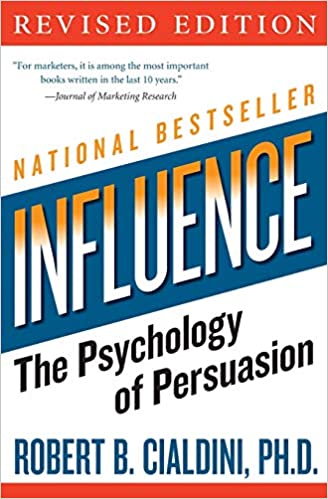There are so many people who have to compromise in life. On the other hand, some people seem to get exactly what they want. It may be the matter of luck. But they can’t depend on luck alone.
They use the art of persuasion to convince people to give them what they want. One can change the behavior or attitude of a person through the use of persuasive language. This type of language is usually used to convince someone to agree with us.

Influence
by Robert Cialdini
⏱ 12 minutes reading time
🎧 Audio version available
But before we begin, here’s a brief explanation of what persuasive language actually is.
What is Persuasive Language?
It is a type of language used by the speaker to convince the audience to agree to his viewpoint. It is an argument aimed at changing someone’s mind. The people who use persuasive language use many techniques to support their argument. This language usually contains logical arguments.
Persuasive Techniques:
People use persuasive techniques to make people to agree with what they are saying. They are all about the ways to persuade and attract anyone. Some of these techniques include:
Evidence
One can make their argument more persuasive by using evidence. By doing so, the readers see the author as more knowledgeable, which makes your argument feel more reliable and logical.
For example: expert opinions, statistics, anecdotal evidence, and research findings.
Using Exclusive and Inclusive Language:
The speaker can persuade the audience by using the exclusive and inclusive language. Exclusive language, such as ‘them’, ‘those people’, and ‘others’ create distance between the listener and the subject. Whereas, inclusive language, such as ‘our’, ‘we’, and ‘us’, creates a sense of responsibility, solidarity, and connection.
Examples:
‘Others don’t want this to happen because…’
‘People like us want to change this’.
Rhetorical Questions
This is a type of question that is asked for effect only and does not require answers. This type of question is asked for when trying to engage the audience. It encourages the audience to consider the issue. Such as ‘Do we really want our next generation growing in a polluted environment?’
Cause and Effect
Your argument must contain a cause and effect relationship. It is very important for persuading your audience.
Connotations
The emotional meaning attached to a word matters. The authors should take special care in choosing their words so that their purposes are suited by the connotation.
For example, ‘Health crisis’ vs. ‘Health issues’ and Freedom fighter’ vs. ‘Terrorist’
Analogy
One persuasive language techniques is the use of analogy. It is a form of reasoning that is used for making a particular point by comparing one thing with another.
Generalization
Generalization means to make arguments about a whole group that is based on a few members of that particular group. It will help you a lot in persuading your audience.
Humor
Humor, adding irony, puns, sarcasm, jokes, and satire, helps by providing a more friendly and engaging tone to the audience. Due to the use of humorous language, the audience is far more likely to stay engaged.
Jargon
The audience can be persuaded by the author that they are expert by the use of specialized terms.
Formal Language
The author can sound more knowledgeable through the use of formal language. It makes the argument feel more rational and reasonable.
Colloquial Language
Colloquial language is everyday, informal, and conversational language. It’s friendly and familiar. It also makes the audience think that the author is on the same page with them. Sounds really good. Doesn’t it?
Repetition
The author can persuade the audience by repeating words, letters, and phrases. It helps him to fix his point of view in the mind of his audience.
Be Empathetic
The use of empathy is a useful persuasive technique. When the reader feels you understand and relate to their experiences, they are more likely to believe you. The audience’s sensitivity can be targeted by using an emotional appeal.
Emphasize Your Point
You can emphasize your point by exaggerating it. It helps you to express exclusivity and urgency. Emphasize to convey an impactful meaning. One can emphasize their point through the use of hyperbolic expressions.
Imagery
One can persuade someone through the use of descriptive language. It is a powerful persuasive technique. You can persuade readers by describing something vividly.
Ethos
An ethical appeal is called ethos. It is used to convince the audience of the author’s character or credibility. The audience can be convinced that the author is a reliable source through the use of ethos. One can develop ethos through the use of appropriate topics and languages for the audience. It will make you seem unbiased and fair.
Pathos
An emotional appeal is called pathos. You can appeal to the emotions of the audience through this technique. Sympathy from the audience can be invoked through the use of pathos. Using this technique, the author can make the audience feel what he wants them to feel. One can develop pathos through the use of emotional tone, meaningful language, stories of emotional events, emotion evoking examples, and implied meanings.
Appealing
It is a persuasive language technique used in writing. Various emotions can be touched through the use of appeal. These emotions include: Fears, protecting their family, desire to seem intelligent and desire to be healthy.
Agitate then Solve
Try to figure out the problem or issue that your audience is facing. Sympathize with them and then offer them solution to solve that issue or problem.
Use of Persuasive Words
One persuasive technique is to use such words that help in persuading the audience easily. One can easily influence the reader’s decision-making power through the use of some powerful words.
Let us now discuss the pros and cons of using persuasive language:
Pros:
- One can change the opinion of the audience through its use.
- It gives the audience hope that their problems can be solved.
- It helps you get what you want.
Cons:
- It can lead to an untruth knowledge.
- The author can betray the audience through its use.
- The author can exaggerate too much.
These persuasive techniques are useful when convincing your audience to agree with you. It is easy to implement these techniques because of their simple nature.
What Is Snapreads?

With the Snapreads app, you get the key insights from the best nonfiction books in minutes, not hours or days. Our experts transform these books into quick, memorable, easy-to-understand insights you can read when you have the time or listen to them on the go.
